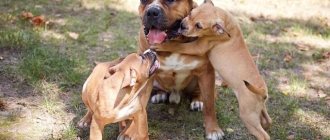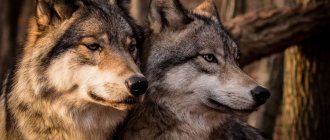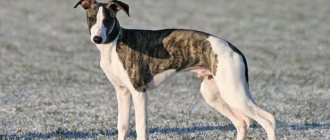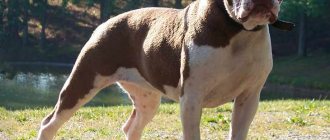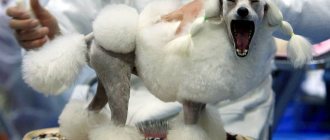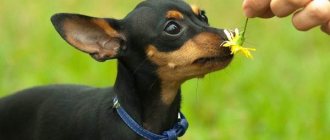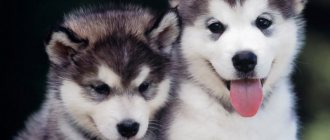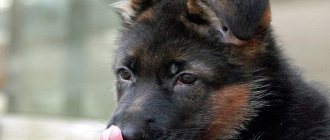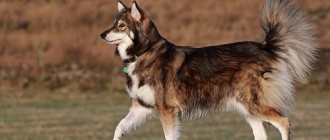Care and maintenance
The dog is quite easy to care for. When going to the kennel for such a dog, you should know some of the nuances of keeping it so as not to make serious mistakes.
- Combing. It is enough to comb short hair once a week - a special mitten is best. During the shedding period (it is not too active and does not last long), you need to get rid of lost hair twice a week.
- Bathing is very rare - 3-4 times a year and only when necessary, for example, if the dog has taken a mud bath.
- There is no need to trim the nails - if the dog runs around enough, then they themselves will grind down just fine.
- It is advisable to examine the eyes every day and, if suppuration is detected, wipe them with a tea solution using a cotton pad.
- Ears. Ear examination every week. If they are dirty, wipe them with a cotton pad soaked in hydrogen peroxide.
- Teeth. Brushing your teeth - twice a month. But if you give your dog bones, chewing toys, or just sticks, then you can avoid this unpleasant procedure.
Walk
Walking should be regular and long. At least twice a day for an hour. And the best thing is to be able to let the dog out of the enclosure and let him run around the area all day.
Loving mother with children
They love walks in the forest. So, breeders living in rural areas can easily go on a picnic with their pet - he will be simply happy. And if you also manage to swim in a river or pond, then the leopard dog will be in seventh heaven.
Healthy! The dog needs to be given physical and intellectual exercise from the first 2-3 months of life. Then it will truly reveal the full potential of the body and brain.
The dog should run often and a lot. Otherwise, serious health problems will begin, and your pet will definitely not be happy.
Training and education
A very difficult question. On the one hand, the dog has a sharp mind and quickly grasps commands. On the other hand, like any hunting dog, it can have its own opinion on a variety of issues. Well, why does the owner throw the ball away and then ask him to bring it? And who needs a good boy to sit, stand, give his paw and bark for no reason? So, it will be difficult to achieve one hundred percent obedience. However, this is not a service dog, so many breeders do not need this at all.
You need to be consistent with your upbringing. If the dog immediately understands that there are certain actions that should never be performed, then there will be no problems. If the owner either allows something or prohibits it, the dog will not be able to learn the rules and will cause a lot of difficulties.
Caring for a Leopard Dog
Caring for a dog of this unusual breed has specific features only in training, but daily procedures and feeding are standard.
General care
The short and dense coat of a leopard dog does not require complex care; it will be enough to comb it with a brush 2-3 times a week to remove lost hairs. Bathing is done as needed, and if it is slightly dirty, you just need to wipe the fur with a damp cloth. No haircut required.
After walks, especially after a hunt, it is important to inspect the dog for ticks, check the eyes, ears and paws for cuts, stuck debris, twigs, etc. Provided regular active walking, the claws do not require trimming - they will be combed to an acceptable length on their own.
Feeding
As with other breeds, there are two types of diets available for Catahoula leopard dogs: store-bought and natural. In the case of industrial food, in addition to quality (super-premium and holistic class), you need to pay attention to the purpose of the product - it should be created specifically for active large pets (Acana Adult Large Breed, Royal Canin Sporting Life Agility Large Dog, Hills Performance) .
Catahoula dogs will need food for active large breed pets
A natural diet should be prepared by a professional - only a balanced, properly assembled menu will provide the dog with the necessary energy and nutrients. It must necessarily include:
- lean meat (beef, turkey, chicken);
- sea fish fillet;
- eggs;
- vegetables and unsweetened fruits;
- low-fat dairy products
You should completely avoid flour, smoked, sweet, pickled, spicy and other dangerous foods. Also, tubular bones and fish bones should not be included in the diet - they can seriously injure the digestive tract.
Training
Aggression among representatives of the breed is usually strictly territorial, that is, in their own territory they will treat a stranger unfriendly, but in neutral territory they will be very loyal and eager to communicate. To prevent the dog from developing unnecessary aggression or fear of other people and animals, it needs socialization from an early age (2-3 months). As for training, in addition to the general obedience course, a work program will be required. But it is worth considering that dogs of large breeds mature more slowly, so if you start training the animal to hunt before the age of one, as is usually the case, you can ruin everything by achieving burnout at an early age. With Catahoula leopard dogs, it is necessary to maintain a balance of play and professional activity, giving the young individual the opportunity to fully have fun and feel like a puppy.
Conditions of detention
The Catahoula Dog is an ideal pet for an experienced and athletic person. Energy and the need for physical activity make regular exercise a necessity for the animal, which, combined with its large size, is not at all suitable for a city apartment. Representatives of the breed will feel great in a private house with a large territory, where the owner will walk them at least 2-3 hours a day, offering various games.
Maintenance and care
An indispensable condition of keeping is a large area for the active life of the dog. Australian heelers are ready to move around the clock. Life in a closed apartment or small yard will become painful for the animal and will negatively affect its character and behavioral characteristics.
It is possible to establish a strong friendship between a person and an Australian heeler; the dog’s character is very loyal and patient
Caring for a reliable companion on all your travels and trips is easy. Nature has endowed them with wool that is capable of self-cleaning; they do not have a specific smell. Frequent washing is harmful to dogs, who may lose this feature.
Bathing twice a year using natural shampoo without chemical components is quite enough for them. Owners wash their dogs only because they are very dirty. Shepherd guards do not need the services of a professional groomer.
The breeders' recommendation for coat care is regular wiping with a wet towel dipped in a weak solution of vinegar.
During shedding, dogs need to be brushed with a special slicker brush or a brush with stiff bristles 3-4 times a week. Male heelers molt once a year, females – twice. Problems with fur matting do not arise with regular grooming.
Particular attention should be paid to the animal's paws due to the physical activity of dogs. Nails are trimmed as needed; they wear down naturally during active jogging.
The vestigial claw can be trimmed once a month. Paw pads need special care - lubricating with baby oil, olive oil or any vegetable oil to avoid cracks.
Another name for the Australian Heeler is the Cattle Dog or Kettle Dog.
It is recommended to regularly cleanse the eyes with chamomile infusion or plain boiled water. The accumulation of contaminants can become a source of infectious disease. The ears are cleaned as necessary with a sponge soaked in oil.
Interesting Facts
When communicating with a leopard dog, special aspects of a difficult nature are revealed:
developed memory - everything undesirable must be eradicated in puppyhood, the behavior of an adult dog cannot be corrected; In their work, Catahoulas acquire their own style based on sight, hearing or smell. Suppressing natural instincts will only spoil the dog; young puppies are included early in work processes from guarding to hunting, as they visually appear to be adult dogs in size. Burnout in puppyhood subsequently leads to professional unsuitability
During the growth period, it is important for puppies to alternate games with serious activities for the correct formation of working qualities.
There were dark periods in the history of dogs when people saw animals as “devils.” Perhaps this attitude was formed from ignorant crossing, the birth of puppies with a disturbed psyche. The heart of a strong dog is responsive to kindness. The biggest reward for a wayward pet is a simple pat on the head and a kind word from the owner.
Education and training
Like many other hunting breeds, the Catahoula is confident and assertive. It is important for the owner to remain a leader in her eyes in order to achieve the desired results in training and education. Consistency, fairness, plenty of praise for a job well done and reprimand for disobedience are important, but without physical punishment or loud shouting. Without socialization, regular exercise, and mental stimulation, Catahoula can be difficult to manage.
The Catahoula Leopard Dog has a very good memory, so owners should not teach it anything that will be unwanted or unacceptable in the future. It is almost impossible to eradicate a habit or correct the behavior of an adult dog.
The patience, time and nerves that the owner will spend while raising and training a leopard dog during the first 1.5-2 years will be rewarded with years spent with a loyal and obedient dog.
Diseases of the breed
Maltipoos, although designer dogs, are distinguished by good health. They can live more than 15 years with proper care. But there are several predispositions that the owner of the breed should be aware of.
Progressive retinal atrophy
The disease is hereditary and leads to blindness. The essence of the disease is that the retinal cells stop functioning - their dysplasia and degeneration occur. The disease affects dogs aged 1 to 5 years.
In the earliest stages, the cells that allow the dog to see in the dark are destroyed. Therefore, the first symptom is disorientation in the dark. If the dog has not previously experienced problems with this, then this obviously indicates the development of retinal atrophy. Then vision is quickly lost during daylight hours.
There is currently no cure for this disease, and in most cases the dog goes blind. To know about a dog's predisposition, you need to pass a special test called ZooProCoDe. It allows you to determine whether or not a dog is a carrier of the disease gene and whether it can become ill with it.
Maltipoo inherited retinal atrophy from a poodle
Epilepsy
It can be primary (inherited) and secondary (acquired). In the first case, epilepsy is incurable, but in the second it is a symptom and can be eliminated with proper measures.
Causes of secondary epilepsy:
- diseases associated with the accumulation of harmful substances in the body;
- developmental problems (hydrocephalus);
- toxic (poisoning with lead, arsenic, organophosphates, strychnine);
- infections (plague, encephalitis, toxoplasmosis, etc.);
- metabolic (low blood sugar, enzyme deficiency, liver and kidney failure);
- food (lack of vitamins, parasites);
- traumatic (severe bruises and injuries).
The most important sign of the disease is the presence of epileptic seizures. They can occur with a frequency ranging from once every few months to once every few days. The duration of the seizure can be from a minute to half an hour, with or without brief periods of consciousness. The dog's eyes roll back, his body spasms, and he may foam at the mouth.
Medicines and therapy can alleviate the animal's condition, but do not completely cure hereditary epilepsy.
Maltipoo may suffer from epileptic seizures
Knee dislocation
Pathology can be either congenital or acquired. There are 4 degrees of dislocation:
- First. The joint adjusts itself when the leg is straightened, and a slight crunch is heard.
- Second. The dog is experiencing discomfort. When realigned, a crunching sound is heard.
- Third. The dog tries to step on the leg as little as possible and keeps it half-bent. The knee is constantly displaced.
- Fourth. The animal does not step on its paw. The knee is constantly displaced.
Grades 1 and 2 are treated by reduction, resting the dog, and the use of chondroprotectors. 3 and 4 may require surgery.
Maltipoo rarely suffer from genetic diseases
Breed characteristics
The Catahoula Leopard Dog is a loyal companion and reliable friend, sociable but not intrusive. They are very active and playful; First of all, it is a working breed. In this regard, they need not just long walks, but also physical exercise that provides sufficient stress. In the presence of other people, they may seem somewhat withdrawn, but in no case will they show aggression or excessive cowardice. They may need time to get used to a stranger. Since they are hunting dogs, their prey drive is very high. On the one hand, this can be used to motivate your pet while working. At the same time, problems may arise when the dog communicates with cats and other pets. In order to prevent this, the puppy needs socialization and education.
Catahoula Leopard Dog Puppy
It is not recommended to keep it in an apartment. The ideal situation for Catahoula is somewhere where there is work for her (such as a farm). Only a person familiar with cynology can own such a dog. Despite all their advantages, Catahoulas can be stubborn and insubordinate. To avoid this, the owner must show his leadership - not through violence, but above all through consistent behavior.
Currently, Catahoula leopard dog kennels are located in the USA (mainly), Germany, the Czech Republic and other countries.
When and how was the leopard dog bred?
The first mention of the breed dates back to the 16th century. An expedition of the Spanish conquistador Hernando de Soto landed near the Catahoula River (or “sacred lake”) in Louisiana (USA). People traveled with dogs, which they used as fighting dogs and hunters. Three years later, Hernando died and his soldiers returned to Spain. Some dogs were left in America, where the Indians used them for their own purposes. History mentions that red wolves often crossed with representatives of this breed, which was the reason for the appearance of “half-wolves.”
100 years later, French settlers arrived in Louisiana with their four-legged friends, many of whom had Beaucerons as ancestors. As a result, the Catahoula breed combines the qualities of mastiffs, bloodhounds, beaucerons and greyhounds. In 1979, the state governor named the breed after the river and announced a new symbol of Louisiana. From now on, they were leopard dogs, which helped many times during search and rescue operations.
Where to buy a Catahoula Leopard Dog puppy
Outside of its homeland, the Catahoula Leopard Dog is extremely rare. About 20 nurseries are located in the states and the bulk of the livestock is concentrated there. There are approximately the same number of kennels in Europe, but the total number of dogs is much smaller, most of them live in Germany, Slovakia, and the Czech Republic. As of 2014, there was only one representative of the breed in Russia in Yekaterinburg. Every year there are more leopard dogs. At the moment there is only one nursery, which began its activities in 2015. But also ordinary owners sometimes engage in breeding, so it is very rare, but advertisements for the sale of Catahoula leopard dog puppies can be found on trading platforms on the Internet.
Price
Puppies of an exclusive rare breed usually cost around 80,000-100,000 rubles. Nurseries in Europe charge an average of 3,000 euros for a leopard baby. Individual representatives of the breed may cost more for breeding and exhibitions.
Appearance
The Catahoula Leopard Dog is a medium to large sized dog (can vary depending on breeding line). It should not have extreme features: neither excessive heaviness nor excessive lightness; it should be moderately dry, strong and fit. A representative of the breed must create the impression of an agile and hardy dog, and all his exterior qualities are assessed precisely from the point of view of their impact on performance.
- The head should be powerful enough, but not exaggerated. Sexual dimorphism is pronounced. A scissor bite is preferred. Eyes of any color or combination of colors are allowed. Dark nose pigment is also optional.
- The coat is short, single-layered, lying close to the body.
- Many colors are acceptable. The most common are red and blue merle (marble). 70% or more white is a serious fault, and >90% (on par with albinism and a completely white head) is a disqualifying fault.
- The height at the withers is: males - 56-66 cm, females - 51-61 cm.
Color “Red Leopard”
Disqualifying faults:
- Aggression or extreme shyness;
- Unilateral/bilateral cryptorchidism;
- Unilateral/bilateral deafness;
- Long and/or fluffy coat;
- More than 90% white; completely white head; albinism;
- Complete absence of tail;
- Cropped ears.
Health and life expectancy
The Catahoula leopard dog is a healthy breed. Hip dysplasia is relatively rare. Other hereditary diseases associated with the merle color include:
- Ophthalmological diseases, blindness;
- Unilateral or bilateral deafness, early hearing loss;
- Probable mortality of newborn puppies or embryos;
- Probability of birth of deformities. More often these are puppies missing an ear or an eye. Puppies with gross abnormalities of the sensory organs die during fetal development or shortly after birth.
- Partial or complete sterility, sperm deficiency in males.
Responsible breeders use genetic testing of breeding stock to reduce the likelihood of disease in puppies. Also, to maintain a dog’s health, timely vaccination, treatment against parasites, good nutrition, care and good living conditions, which include a sufficient level of physical activity, are important. Life expectancy is usually 11-13 years.
How to choose a puppy
If a person has decided that he will get one as a pet, then first he needs to prepare the house for the arrival of a Sheltie puppy. There are some recommendations for this:
- hide valuables (shoes, papers, valuables);
- hide small objects (the puppy may swallow a dangerous object);
- remove wires, cords, and cables from sight;
- prepare toys for the puppy so that he does not harm things;
- the floor surface should not be slippery so that the puppy does not get injured;
- It is necessary to prepare a place for the dog to feed and sleep.
When purchasing a puppy, you should give preference to experienced breeders or a nursery. If a pedigree is provided, this provides a guarantee that the dog is purebred and also has no health problems.
When choosing a puppy, you should pay attention to the following points:
- the puppy looks healthy and playful in appearance;
- eyes and ears are clean;
- the color matches the description of the standard, there are no additional shades or impurities;
- weight of a 1.5-2 month old puppy – from 1.2 to 2 kg;
- The dog's physique is strong, its body features are symmetrical, its limbs are straight;
- There is no lameness when walking.
You can ask the breeder to show the puppy's parents to see what it will ultimately become.
The Shetland Sheepdog is not one of the commercial breeds; Sheltie breeding is carried out by lovers of pure genetics and breed standards. This affects not only the quality of the offspring, but also the cost of the dog.
You can buy a Sheltie puppy from a professional breeder for 30-35 thousand rubles, taking into account the fact that there is a pedigree and the parents are show dogs. If the dog is not purchased for exhibitions, then its cost will be 15-20 thousand rubles.
When purchasing a Sheltie, you should know that this dog needs proper care and maintenance. Wool requires special care, but if it is provided, there will be no problems. You don't need any skills to become friends with a Shetland Sheepdog. It is enough to instill in her basic rules of behavior and go for walks more often. This breed of dog is devoted to its owner in everything, so if you give it love and care, it will reciprocate.
Character
These animals show aggression only during hunting, under the close control of the owner and direct it towards the specified game. In ordinary life, increased excitability or rigidity of character can be considered a vice. At the other extreme, a recognized reason for rejection is excessive cowardice or shyness. They are very playful and cheerful and need constant activity and work.
Do not forget that this is, first of all, a working dog , called to serve its owner and throughout its centuries-old history, it has performed exactly this task. For this reason, it is not recommended to have a Catahoula as a lap dog.
In a confined space, the animal's temperament will deteriorate sharply, since it will not be able to get an outlet for the accumulated energy. Even regular walks will not correct the situation. It is one thing to be in constant training mode, to chase game in the forest, to perform the work of a guard and even a shepherd, and quite another to lie on a rug in an apartment, waiting for the owner to return from work, and then take an evening exercise around a residential area in a collar and on a leash.
But they are perfectly trainable , do not try to gain a leading position and unquestioningly give their owner the leading role. But at the same time they have a rather stubborn character. Catahoula training should be carried out by experienced specialists; for beginners this activity will be beyond their capabilities.
You cannot show aggression or punish the dog for not following orders. Such behavior on the part of a person can cause aggression or affect the pet’s future relationship with its owner. Depending on the chosen line of training, a Catahoula can make either an ideal hunter or a vigilant shepherd.
As for behavior in the family, this is a very faithful and devoted friend. He gets along well with children over seven years old. He will be indifferent to very small crumbs. Usually attached not to one owner, but to the whole family at once. He can be used as a guard. Treats strangers with caution and distrust. He needs to communicate with people, but does not show it intrusively.
What to feed?
There are no special recommendations for feeding representatives of this breed. Of course, the diet should be complete and balanced according to BJU. Food is selected taking into account the age of the pet
You should pay attention to ready-made super-premium dry food designed for dogs with an active lifestyle.
Natural feeding is also allowed. In this case, the pet’s menu must include meat and offal. The proportion of such components is calculated as follows: 40 g per 1 kg of weight for young individuals and 10-15 g per 1 kg of weight for adults. The animals are also given cereals, eggs, and vegetables. Fermented milk products are also useful.
Choosing a puppy
Buying a Catahoula dog puppy is quite difficult, since there is only one official certified kennel in Russia. The other closest one is located in Slovenia. When choosing a baby, you should pay attention to:
- Availability of all documents.
- Pet's appearance. The choice is usually small due to the rarity of the breed. But the future pet should immediately evoke sympathy.
- Behavior and its correspondence to the owner’s lifestyle. A young dynamic person will choose an active dog. Phlegmatic people will prefer a less playful baby.
The price of a purebred dog puppy for January 2021 is from 50 thousand rubles.
Catahoula puppy will quickly become everyone's favorite
Feeding
This rare dog is not capricious and picky about food, so the owner can decide for himself what he will feed his pet - ready-made industrial food or natural food
In the first case, products ranging from super-premium are purchased; it is important to provide the pet with round-the-clock access to clean water
In the second, food is prepared in a separate pan individually for the dog; it is unacceptable to give it the same thing that the owner eats. It is difficult to provide your pet with all the necessary vitamins and minerals in natural form with this feeding option. Therefore, the animal is additionally given ready-made complexes. A veterinarian can help you choose a specific vitamin name.
You can give your dog:
- Boiled or raw, but pre-frozen lean meat.
- Offal (heart, liver, kidneys).
- Sea fish (necessarily cleaned of scales and bones).
- Vegetables and fruits as sources of vitamins.
- Porridge.
Note! Meat should make up 70% of the diet. You should not give your pet cheap, economy-class food, even occasionally. The Catahoula gastrointestinal tract is not adapted to digest them, so the risk of problems with the digestive system increases
It is also unacceptable to treat your dog with sausages, frankfurters, sausages, cutlets and other human delicacies. Sweets, pastries, pasta, soups prepared with salt and spices are also prohibited. And, of course, alcohol - it should not be given even in tiny quantities.
Catahoula's gastrointestinal tract is not adapted to digest them, so the risk of problems with the digestive system increases. It is also unacceptable to treat your dog with sausages, frankfurters, sausages, cutlets and other human delicacies. Sweets, pastries, pasta, soups prepared with salt and spices are also prohibited. And, of course, alcohol - it should not be given even in tiny quantities.
You should not give your pet cheap, economy-class food, even occasionally. Catahoula's gastrointestinal tract is not adapted to digest them, so the risk of problems with the digestive system increases. It is also unacceptable to treat your dog with sausages, frankfurters, sausages, cutlets and other human delicacies. Sweets, pastries, pasta, soups prepared with salt and spices are also prohibited. And, of course, alcohol - it should not be given even in tiny quantities.
The look of Catahoula touches the soul, the owner is ready to give the dog his favorite treat at least every hour
Basic rules of care
It is recommended to brush Albanian pit bulls with a brush for short-haired dogs or a special mitten once a week. They are bathed no more often than once every 2 months, and it is recommended to use hypoallergenic shampoos for short-haired dogs.
Ears and eyes should be examined regularly, but cleaned only when they become dirty and, preferably, using special cleaning products.
You can brush your pet's teeth 1-2 times a week with a toothbrush and dog toothpaste, or simply give him chewing toys or treats designed to remove plaque.
Nails are trimmed with nail clippers if they grow excessively and begin to curl inward, causing discomfort to the dog.
Albanian Pibuls are not intended for year-round outdoor keeping because due to their short coat and complete absence of undercoat, they do not tolerate frost well.
Life expectancy and major diseases
Unfortunately, due to long-term inbreeding, as well as the common merle color, which dog breeders around the world hate, leopard dogs often develop serious illnesses.
- Joint dysplasia is an eternal companion of all large dogs, especially with poor nutrition.
- Deafness is a common genetic disease, especially common in dogs whose color is predominantly white. It can be either full or directed.
- Blindness - usually occurs in dogs whose both parents were merle colored - here the risk is at least 25%.
Note! Life expectancy is fairly standard for large dogs - an average of 12-14 years.
However, good or negative care, feeding and attention to health can either increase or decrease this period.
Origin of the breed
The breed was bred in the USA in the state of North Carolina in Catahoula County. It is believed that its appearance is closely related to the development of these lands by settlers. They were the ones who brought dogs here from Europe.
Recent research has shown that the leopard hound is genetically close to the British and French hounds. It is believed that this breed also has some wolf blood. Most likely, a cross between a red wolf and a native Indian dog was originally bred, which was then mixed with the dogs of the first settlers.
The leopard hound, which appeared among the first colonists, helped them in hunting, protected them from Indian raids, and performed other everyday tasks. This dog became so popular that in 1979 it was declared a state national treasure.
History of the breed
The exact origins of the Catahoula leopard dog are unknown. And as always in such situations, there are several theories. The first is the crossing of Molossian dogs (large individuals native to Molossia, a region of ancient Epirus) and greyhounds, which appeared in Louisiana with the Spaniards in the 16th century.
The second theory is that the breed originated much later, in the 19th century, after the French brought the Beaucerons (French shepherd dogs, an ancient and rare breed) to America. And the leopard dog supposedly came from crossing Beaucerons and red wolves. Although it is a little unclear, because almost at the same time the French had already seen strange-looking dogs with transparent, glass-like eyes, which were used by the Indians to hunt game in the swamp.
The third theory claims that it was the result of crossing indigenous dogs of local Indians with red wolves (hybrids of the gray wolf and coyote, native to America, which have practically disappeared and are listed in the Red Book). But this theory is not supported by modern DNA analysis.
Be that as it may, in 1979 the government of Louisiana declared it the official state symbol in recognition of the importance of this breed in the history of the state. A dog of “noble Louisiana origin” recalls the prosperity of this state.
Hunting hounds
The largest number of hunting breeds belongs to the hounds. They can run after game for up to hundreds of kilometers without getting tired, and are widely used for baiting.
Basset Hound
Bassets come from England, are small in size, weighing up to 30 kg. They are persistent and can chase an animal for a long time, although they are not able to develop great speed. An excellent sense of smell allows you to find the animal again even if you lose sight of it. Bassets are usually taken for hunting on foot.
Austrian Hound
This dog has short black hair and a muscular body. She jumps high, is resilient, can run for a long time, and is not afraid of any animal. Widely used only in Austria; in other countries it occurs in isolated cases.
Beagle
English Beagle puppies are incredibly cute, beautiful - white with large black and brown spots on their backs. Dogs have keen eyesight, an excellent sense of smell, they are hardworking and resilient. Hunting requires preliminary training in the form of a game.
Bloodhound
A dog of this breed will feel the “aroma” of the wanted animal even after 10 days. She is good at pursuing, especially wounded animals, as her name suggests (derived from the word “blood”). The downside is stubbornness, so you will have to persistently train the dog. It is best to use a diarrhea with glued feathers or animal down.
Finnish hound
A powerful dog originally from Finland, it is widely used for baiting hare and fox. She picks up the bird and chases it towards the hunter. The breed can be used even in harsh climates; it has a dense undercoat, although the dog does not really like winter walks.
Drever
Drever (Dachsbrak) is a Swedish short-legged hound, resembling a dachshund in body shape. At home she is kind and gentle, but on the hunt she is daring and brave. Used for catching roe deer, hare, fox, wild boar, works alone or in a group. The dog drives the animal towards the hunter. The downside is the low speed.
Rhodesian Ridgeback
Bred in South Africa, distributed throughout the world. Initially used to catch lions, it is suitable for any large animal. The dog is strong, muscular, very hardy and courageous. Can be used as a security guard.
Dalmatian
The recognizable breed is black and white, spotted. Can hunt down any prey thanks to its stamina. It has a difficult character and will require patience to train. With the wrong approach, the Dalmatian will frighten the game, but not drive it, although after training it will gladly bring it to its owner.
English Foxhound
Designed for catching foxes, it also hunts hare well. Usually works in a group of relatives, but alone it will become an assistant to the hunter. Training is carried out strictly, otherwise the animal quickly begins to be lazy.
American Foxhound
It is an excellent beater of wild boars and foxes. No less dexterous when hunting raccoons, pumas and even bears. The American Foxhound is able to work in the cold, is hardy, but stubborn, and requires a long training period.
Veneri
Small Anglo-French hounds that cannot exist for a long time without hunting walks. The reaction is fast, the strength is high, the animals are suitable for driving small and large animals. Show excellent results on any terrain.
Historical reference
There is no exact information about the origin of the breed yet, but many myths and legends are associated with the Catahoula dog. There is a belief that in ancient times these dogs accompanied the Choctaw Indians who lived on the shores of Lake Catahoula. That is why the breed got its name, which translates as “clean lake”.
The Louisiana Leopard Dog is a charming pet with a difficult temperament.
Note! It is believed that the name of the breed was given in honor of the amazing sky-colored eyes of these dogs.
The first written mention of the breed dates back to the 16th century. Modern dogs are the result of a complex crossbreeding of aboriginal representatives and French herding Beaucerons. At the beginning of the 20th century, the breed was brought to the brink of extinction, but through the efforts of breeders it was saved. In 1951, fans of the breed founded the National Louisiana Catahoula Dog Association. A breed standard was formulated, and since 1979 these dogs have taken part in international exhibitions. However, they have not yet received recognition from the International Canine Federation.
Interesting Facts
Here are some unusual features of Catahoula dogs:
- They have an amazing memory, but are stubborn. Therefore, the fight against behavioral defects should begin at an early age.
- Puppies mature quickly and at 9 months they become similar in appearance to adult dogs.
- They are just as quickly able to engage in the activities intended for them. Catahoulas are universal dogs, suitable for hunting, guarding, and being a companion - they approach everything responsibly.
- They love to swim and do it well thanks to the membranes between their toes.
Amazing color and stunningly beautiful blue eyes are the strengths of this breed.
Kinds
Catahoulas come in a variety of colors including blue merle, red merle, brindle and solid colors. Merle is a coat with uneven coloration in the form of dark and lighter areas of the same color. The result is a “marbled” look. Sometimes the more permanent color is "sprinkled" with patches of other colors, such as white patches on the chest, legs or face.
Actually, the “merle” gene is responsible for the “leopard” color of the dog. Moreover, it happens that it manifests itself especially clearly not on the entire coat, but in certain places. We will present to you the most popular colors of the Catahoula dog, although we repeat that coat color is not a priority when choosing a dog; it does not affect its quality in any way.
- Red Leopard - Various shades of brown, sometimes with small white spots. Known as "red merle".
- Blue leopard - various shades of gray, from light to black, sometimes with rare white spots. Known as "blue merle".
- Black or black leopards are the least affected by the merle gene, but still have blue or gray spots.
- Gray or silver leopard is a blue leopard where the black color has been diluted to gray. Known as "merle slate".
- Tri-color - usually three colors are involved - black, gray, white.
- Four-color or five-color - dogs with different colors, brown and blue of different shades are added to the three main colors.
- Patchwork are predominantly white dogs with a small amount of merle spots throughout their coat. They can be black and brown. If you breed these merles further, you can achieve grey, blue, red or liver colors in them.
In addition to colors, it is appropriate to talk about the breeding lines of this breed, on which the size of dogs of this breed depends. There are three similar lines:
- The Wright line is the largest line of Catahoulas, weighing 40 to 50 kg, and was designed by Perston Wright. This line were specimens originally produced from dogs that arrived with Hernando de Soto (16th century Spanish conquistador, conqueror of the New World).
- The Fairbanks line is the next largest, weighing 30-35 kg. Was developed by Mr. Lavi Fairbanks. They were different shades of yellow, including brindle.
- McMillin Line. This blue glass-eyed Catahoula, measuring approximately 50 pounds, was developed by Mr. McMillin of Sandy Lake, Louisiana.
These three lines were the progenitors of all variations of Catahoulas known today.
General information and breed standards
Before getting such an unusual pet, it would be a good idea to find out a detailed description of its appearance.
The rather large size catches the eye - the height at the withers of males reaches 56-66 cm, and that of females - 51-61 cm. However, with such outstanding growth they cannot be called heavy - the weight ranges on average from 16 to 37 kg, that is, The dog is quite lean and not too tightly knit.
The coat is single-layered, lying close to the body, and not too long.
Pronounced heterochromia
The color range is quite rich - almost all colors are possible. True, marble (aka blue merle) and red colors still prevail. But if the dog is 70% or more white, then this is a serious application for marriage.
There are no special requirements for the eyes - any colors are possible and even heterochromia is not a defect.
